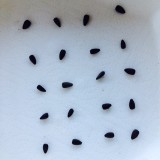 Many seeds are viable a lot longer than you might think. For example, seeds of lettuce, cucumbers, eggplant, radish, cabbage, spinach, and musk melon are good for five years if stored under cool dry conditions. This means that you can use part of a package of seed one year and keep the rest for use in the following five years; there is no need to buy fresh seeds every year. Still, you might be hesitant to plant seed from previous years without some indication that the seed is viable and there is a simple way to find out.
Many seeds are viable a lot longer than you might think. For example, seeds of lettuce, cucumbers, eggplant, radish, cabbage, spinach, and musk melon are good for five years if stored under cool dry conditions. This means that you can use part of a package of seed one year and keep the rest for use in the following five years; there is no need to buy fresh seeds every year. Still, you might be hesitant to plant seed from previous years without some indication that the seed is viable and there is a simple way to find out.
Most seeds germinate in the dark but a few need light. The process of testing the germination rate is basically the same but has to be altered to accommodate the light requirement. Some common seeds that need light are: ageratum, begonia, balloon flower, bellflower, Chinese lanterns, chrysanthemum, coleus, columbine, English daisy, feverfew, foxglove, gaillardia, lobelia, oriental poppy, petunia, portulaca, primrose, scarlet sage, Shasta daisy, snapdragon, strawflower, and sweet alyssum. Notice that all the seeds that need light for germination are all flowers. Vegetables generally germinate in darkness.
Some seeds, like parsley take three weeks to germinate while other seed such as lettuce germinate in three days so continue to check the seeds accordingly. Most seed packages give the number of days needed for germination.
Directions for Determining the Germination Rate of Seeds that Germinate in Darkness
1. Moisten a large piece of paper towel.
2. Place about 20 or more seeds on the paper towel, spacing equally but an inch or so away from the edges.
3. Roll up the paper towel so that all the seeds are within the roll.
4. Place the roll in a plastic bag.
5. Place the plastic bag in an area where temperatures are between 70 and 80 F.
6. Check the seeds in two to three days and every day thereafter for a week or so looking for the emergence of the root. Once the root appears germination has occurred.
Directions for Determining the Germination Rate of Seeds that Need Light for Germination
1. Moisten two pieces of large paper towel.
2. Place the moistened paper towels in a tray or plate.
3. Place about 20 seeds or more on the paper towels, spacing equally apart.
4. Put the container with the paper towels and seeds in a plastic bag or cover with plastic wrap.
5. Place the seed containers in an area where temperatures are between 70 and 80 F.
6. Check the seeds in two to three days and every day thereafter for a week or so looking for the emergence of the root. Once the root appears germination has occurred.
